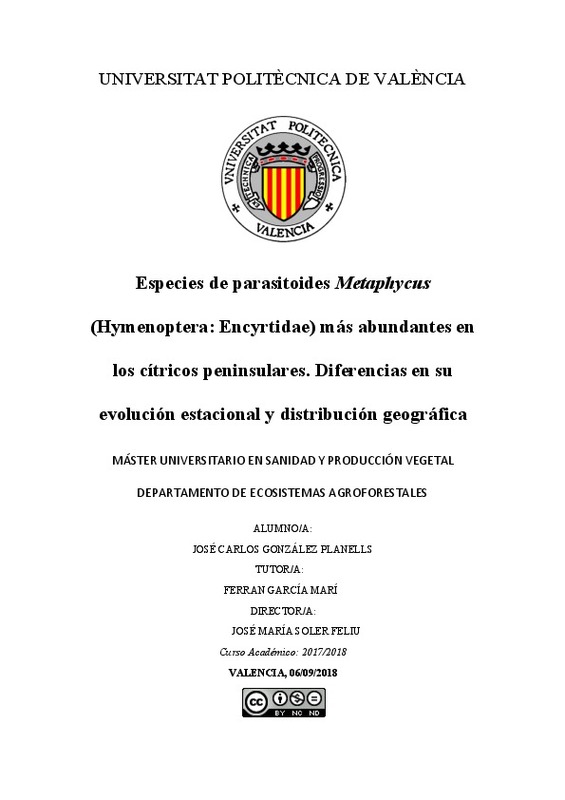JavaScript is disabled for your browser. Some features of this site may not work without it.
Buscar en RiuNet
Listar
Mi cuenta
Estadísticas
Ayuda RiuNet
Admin. UPV
Especies de parasitoides Metaphycus (Hymenoptera: Encyrtidae) más abundantes en los cítricos peninsulares. Diferencias en su evolución estacional y distribución geográfica
Mostrar el registro sencillo del ítem
Ficheros en el ítem
| dc.contributor.advisor | García Mari, Ferran
|
es_ES |
| dc.contributor.advisor | Soler Feliu, Jose-Maria
|
es_ES |
| dc.contributor.author | González Planells, José Carlos
|
es_ES |
| dc.coverage.spatial | east=-0.4258911614417684; north=39.37644778599085; name=Este de España, Espanya | es_ES |
| dc.coverage.spatial | east=-6.094836473941768; north=37.31432702896977; name=Sur de España, Espanya | es_ES |
| dc.date.accessioned | 2018-12-17T08:04:44Z | |
| dc.date.available | 2018-12-17T08:04:44Z | |
| dc.date.created | 2018-09-21 | |
| dc.date.issued | 2018-12-17 | es_ES |
| dc.identifier.uri | http://hdl.handle.net/10251/113880 | |
| dc.description.abstract | [ES] En el cultivo de los cítricos existen numerosas especies de artrópodos fitófagos que pueden causar daños de importancia económica al cultivo. Entre ellas, se encuentran los hemípteros de la familia Coccidae, como Coccus hesperidum, C. pseudomagnoliarum, Protopulvinaria pyriformis, Saissetia oleae, Saissetia coffeae, entre otros. Las poblaciones de estos fitófagos se encuentran controladas de forma natural, evitando que se alcance el nivel de plaga, por los enemigos naturales, destacando entre ello como más importantes los himenópteros Encyrtidae del género Metaphycus (Himenóptera: Encyrtidae). Metaphycus helvolus, M. flavus y M. lounsburyi, son las tres especies del género Metaphycus más abundantes en parcelas de cítricos en la Península Ibérica. En el presente trabajo, se estudió la evolución estacional, la distribución geográfica, la abundancia absoluta y relativa, de M. helvolus, M. flavus y M. lounsburyi, en base a seguimientos semanales en trampas amarillas en 17 parcelas en 2015 y en 10 en 2016, distribuidos por toda la zona citrícola del este y del sur de la Península Ibérica, integradas en los programas de Red de Monitoreo Online (Bayer) y Food Chain Partnership. Metaphycus helvolus, fue la especie más abundante representando el 67.8 % respecto del total, seguido de M. flavus con 23.7 % y, por último, M. lounsburyi con un 2.31 %. En cuanto a la evolución estacional, las especies M. helvolus y M. flavus, estuvieron presentes a lo largo de todo el periodo de estudio, intensificándose entre los meses de junio a septiembre, mientras que, la especie M. lounsburyi estuvo presente entre los meses de junio a agosto, principalmente. Se observó, una pauta definida de evolución geográfica, siendo M. helvolus y M. lounsburyi más abundantes en las zonas del norte, mientras que M. flavus, fue más abundantes en las comarcas del Sur. Se escribe y se aportan datos biológicos sobre una posible nueva especie de Metaphycus denominada Metaphycus? gilvus en el Continente Europeo. | es_ES |
| dc.description.abstract | [EN] In citrus there are numerous species of phytophagous arthropods that can cause economic damage to this crop. Among them, there are the order Hemiptera of the family Coccidae such as Coccus hesperidum, C. pseudomagnoliarum, Protopulvinaria pyriformis, Saissetia oleae, Saissetia coffeae ¿ etc. The populations of these phytophages are controlled in a natural way, preventing the status of pest from being reached, by natural enemies, among which the Hymenoptera Encyrtidae of the genus Metaphycus (Hymenoptera: Encyrtidae) stand out as more important. Metaphycus helvolus, M. flavus and M. lounsburyi, are the three most abundant species of Metaphycus in citrus orchards in the Iberian Peninsula, being the main and most effective species, used for the biological control of soft scales. In the present work, the seasonal evolution, geographic distribution, absolute and relative abundance of M. helvolus, M. flavus and M. lounsburyi were studied, based on weekly traps in yellow traps in 17 plots in 2015 and in 10 in 2016, distributed throughout the citrus area of the east and south of the Iberian Peninsula, integrated into the Online Monitoring Network (Bayer) and Food Chain Partnership programs. Metaphycus helvolus, was the most abundant species representing 67.8% of the total, followed by M. flavus with 23.7% and, finally, M. lounsburyi with 2.31%. Regarding the seasonal evolution, the species M. helvolus and M. flavus, were present throughout the study period, intensifying between the months of June to September, while, the species M. lounsburyi was present among the months from June to August, mainly. A definite pattern of geographical evolution was observed, with M. helvolus and M. lounsburyi being more abundant in the northern areas, while M. flavus was more abundant in the southern regions. Is written and provided with biological data on a possible new species of Metaphycus called Metaphycus? gilvus in the European Continent. | es_ES |
| dc.language | Español | es_ES |
| dc.publisher | Universitat Politècnica de València | es_ES |
| dc.rights | Reserva de todos los derechos | es_ES |
| dc.subject | Metaphycus | es_ES |
| dc.subject | Coccidae | es_ES |
| dc.subject | Abundancia | es_ES |
| dc.subject | Evolución estacional | es_ES |
| dc.subject | Distribución geográfica | es_ES |
| dc.subject | Cítricos | es_ES |
| dc.subject | Abundance | |
| dc.subject | Seasonal trend | |
| dc.subject | Geographical distribution | |
| dc.subject | Citrus | |
| dc.subject.classification | PRODUCCION VEGETAL | es_ES |
| dc.subject.other | Máster Universitario en Sanidad y Producción Vegetal-Máster Universitario en Sanitat y Producció Vegetal | es_ES |
| dc.title | Especies de parasitoides Metaphycus (Hymenoptera: Encyrtidae) más abundantes en los cítricos peninsulares. Diferencias en su evolución estacional y distribución geográfica | es_ES |
| dc.type | Tesis de máster | es_ES |
| dc.rights.accessRights | Abierto | es_ES |
| dc.contributor.affiliation | Universitat Politècnica de València. Departamento de Ecosistemas Agroforestales - Departament d'Ecosistemes Agroforestals | es_ES |
| dc.description.bibliographicCitation | González Planells, JC. (2018). Especies de parasitoides Metaphycus (Hymenoptera: Encyrtidae) más abundantes en los cítricos peninsulares. Diferencias en su evolución estacional y distribución geográfica. http://hdl.handle.net/10251/113880 | es_ES |
| dc.description.accrualMethod | TFGM | es_ES |
| dc.relation.pasarela | TFGM\95152 | es_ES |






